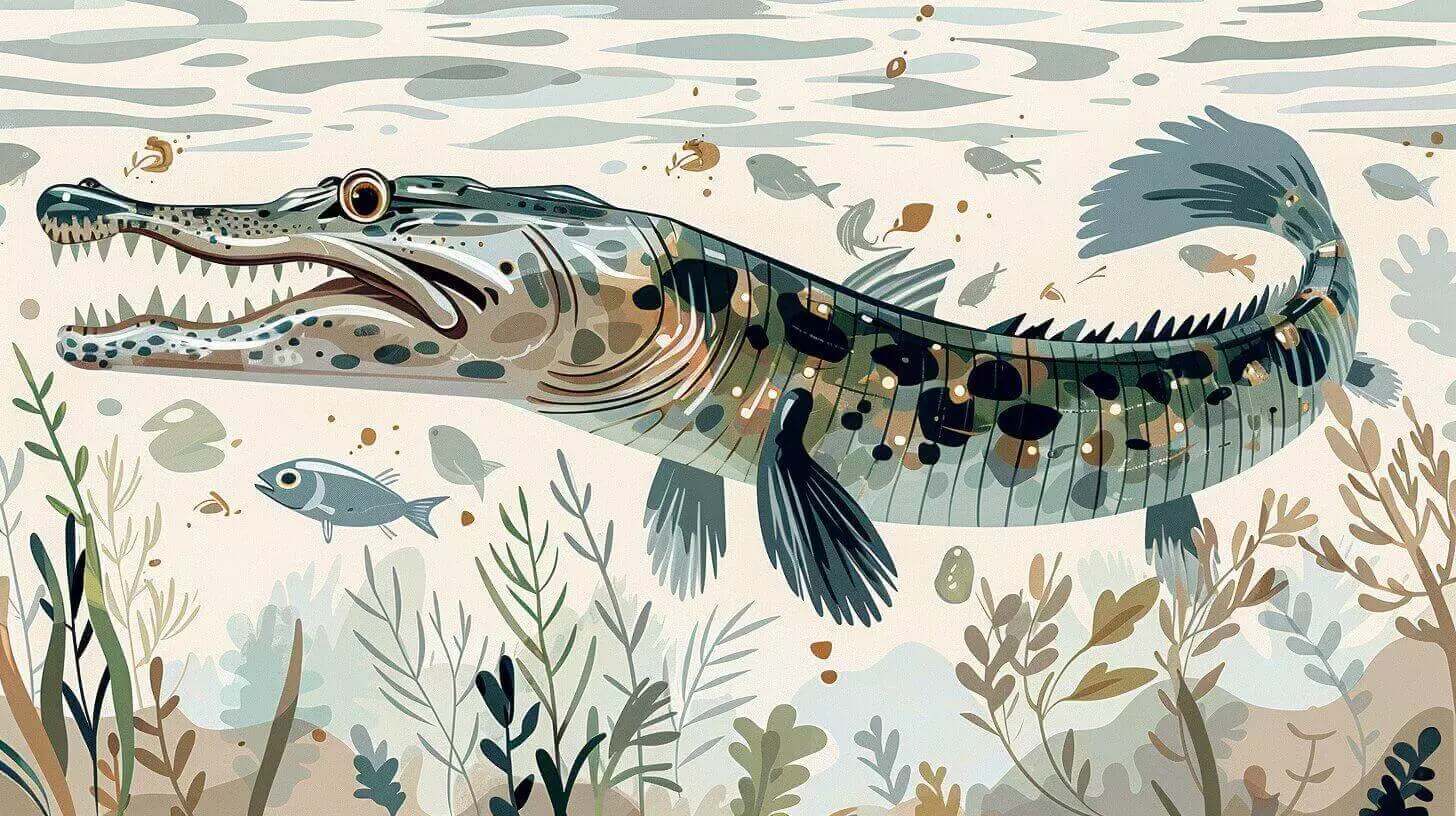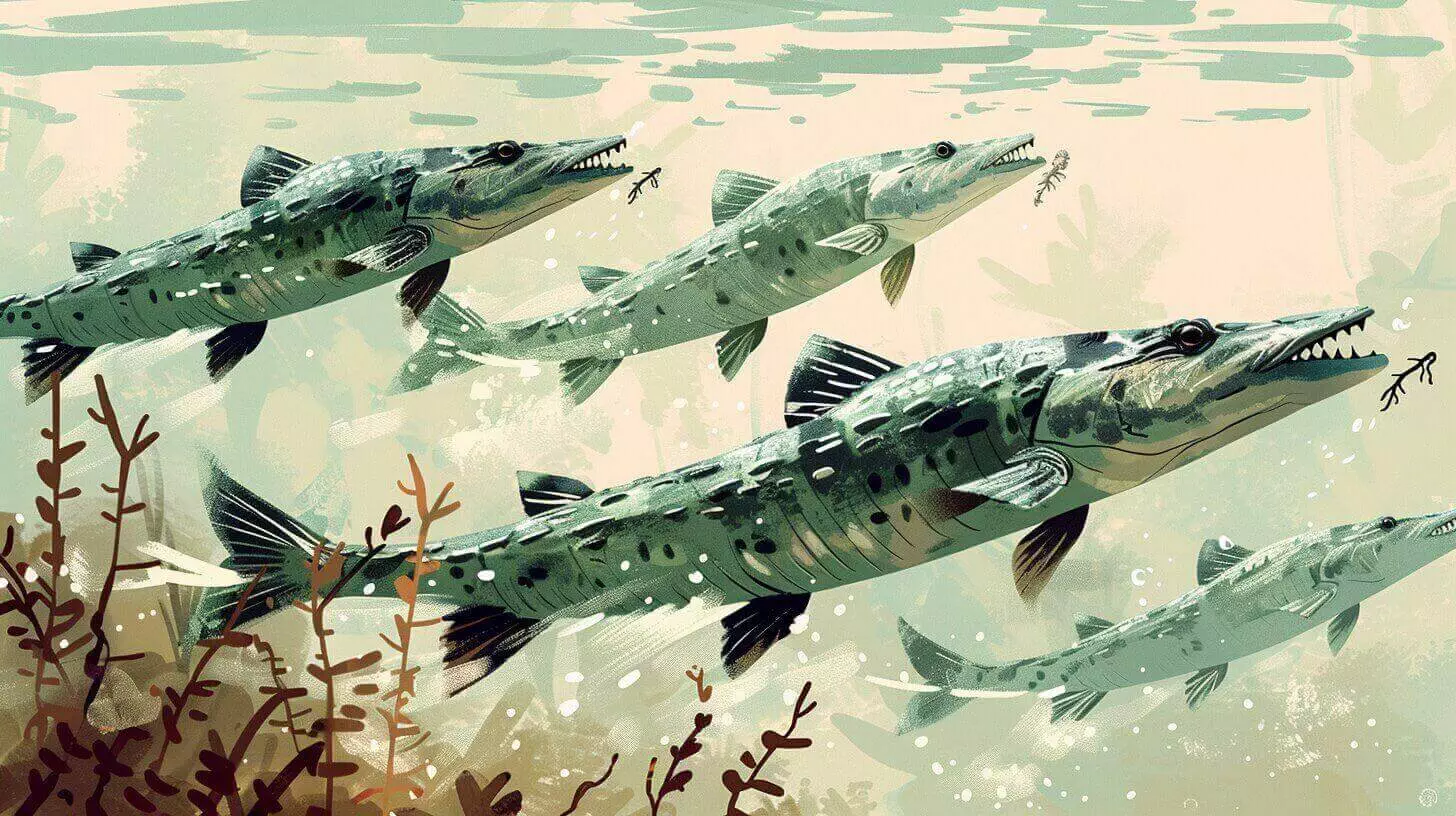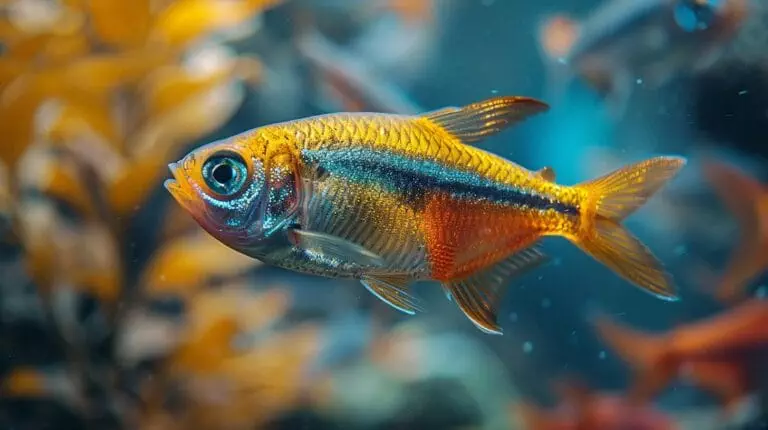Gar fish are odd-looking creatures. You might wonder, “What do gar fish eat?” These ancient fish have a big appetite. They’re top predators in many U.S. waters. Alligator gar, the largest type, can grow up to 10 feet long! 1
As an aquarist with years of experience, I’ve studied these fascinating fish. Gar have a unique diet that changes as they grow. Their armor-like scales and sharp teeth help them hunt.
Ready to learn more about what gar fish eat? Let’s explore their feeding habits. 2
Key Takeaways
- Gar fish eat mostly other fish, but also crabs and birds. Their diet changes with seasons.
- Young gar eat tiny water bugs and small fish. Adult gar can eat fish up to 3 feet long.
- Alligator gar, the largest type, can grow to 10 feet and 300 pounds. They mainly eat carp, tilapia, and shad.
- Gar fish have been around for over 100 million years. They have tough scales and can breathe air.
- The U.S. Fish and Wildlife Service works to protect gar fish. They limit catches to 5% per year to keep numbers stable.
Understanding Gar Fish Species and Their Primitive Nature

Gar fish are living fossils. They’ve been around for over 100 million years, with tough scales and a unique ability to breathe air.
Different Gar Species in U.S. Waters
U.S. waters house seven gar species. 1 These ancient fish live from southern Canada to Costa Rica. 1 Alligator gar stands out as the largest type. It can grow up to ten feet long and weigh over 300 pounds. Gar fish have tough, armor-like scales that protect them.
Gars are living fossils, unchanged for millions of years. – Fish biologist
Gar species vary in size and habitat. Some prefer rivers, while others thrive in lakes. You’ll find longnose gar in many eastern U.S. waterways. Spotted gar inhabit calm waters with plants. Each type plays a unique role in its ecosystem.
The Alligator Gar as a Misunderstood “Trash Fish”
Alligator gar, Texas’s largest freshwater fish, got a bad rap as “trash fish” for years. You might think these 8-foot, 300-pound giants harm game fish, but that’s not true. Since the 1980s, anglers have started to see their value.
Research shows stable gar populations in Texas with low harvest rates. 2 These ancient fish mainly eat carp, tilapia, and shad. Game fish make up only 20% of their diet. Studies prove gar have little impact on bass numbers.
In fact, they help keep ecosystems balanced. As an aquarium hobbyist, you can appreciate how each species plays a key role in nature’s harmony.
Life History of Gar Fish
Gar fish have a long and fascinating history. These ancient creatures have swum in our waters for over 100 million years. 4 You’ll find them in many U.S. rivers and lakes today. Gar grow slowly but can live for decades.
Female gar take about 10 years to reach sexual maturity, while males mature in about 5 years. 3 In spring, when water temps hit 68°F to 82°F, gar spawn in shallow, plant-rich areas. Their eggs stick to plants and hatch in a week or so.
Young gar eat tiny water bugs, while adults hunt other fish. Let’s explore what these prehistoric predators eat in their natural habitat.
What Do Gar Fish Eat in Their Natural Habitat?

Gar fish are skilled hunters in rivers and floodplains. They eat a mix of fish, crabs, and birds – their diet changes with the seasons.
Hunting Behaviors in the River and Floodplain
Alligator gar hunt in rivers and floodplains with stealth. They lurk near the surface, waiting for prey. Their long bodies help them stay still in the water. When fish swim by, they strike fast. These predators eat mostly other fish, but also grab crabs in salty areas.
At night, alligator gar become more active hunters. They swim through flooded forests and fields looking for food. Their tough scales protect them as they move through plants and logs. Young gar eat small fish and bugs. As they grow, they go after bigger meals like catfish and carp. 5
Alligator gar are the ultimate ambush predators of our rivers. – Dr. Solomon, Fish Biologist
Seasonal Changes in Gar Fish Diet
Gar fish adapt their diet as seasons change. Their main prey, gizzard shad, stays constant year-round. But other food sources shift with the seasons. In spring and summer, more fish species become available. Gar take advantage of this bounty. They eat a wider variety of fish during these warmer months. 6
Fall and winter bring changes to gar diets. Prey fish may become scarce. Gar adjust by targeting different species. They might eat more bottom-dwelling fish or even some plants. This flexibility helps gar survive tough times. Your aquarium gar will show similar patterns if you vary their food with the seasons.
Research by Fish and Wildlife Service
U.S. Fish and Wildlife Service studies gar fish habits closely. They track what gar eat and how they live. Their work shows that young gar like small prey. This includes tiny water animals and fish fry.
As gar grow, they switch to bigger meals. Adult alligator gar can eat fish up to 3 feet long! The service also maps where gar live. They found that alligator gar swim in rivers from Ohio to the Gulf of Mexico. This info helps protect gar habitats. 7
Fish and Wildlife teams use special tools to study gar. They put tags on fish to follow their moves. They also look at gar stomachs to see what they’ve eaten. This research helps fish fans like you understand these cool, ancient fish better.
It shows how important gar are to river life. The data guides rules to keep gar safe and healthy in the wild. 8
Alligator Gar Feeding Patterns

Alligator gar hunt with stealth and power, using their tough scales and sharp teeth to catch prey. Want to know more about these ancient fish? Keep reading!
How Solomon and Others Came Across Gar Behaviors
Dr. Solomon David’s fascination with gars began at age 11. A photo in _Ranger Rick_ magazine sparked his interest in these ancient fish. Scientists study gar behaviors through field observations and research. They track gar movements, feeding patterns, and habitat use. This helps them understand how gars interact with their environment. 9
Researchers use various tools to study gar behaviors. These include sonar, tracking devices, and underwater cameras. They also analyze gar stomach contents to learn about their diet. This research reveals that gars often eat shad and other small fish. 1
Protective Scales and Hunting Advantages
Gar fish have amazing armor. Their scales are tough as bone and coated with enamel. This shield keeps them safe from most predators. You’ll notice these scales look like diamonds on the fish’s body. They’re so strong, Native Americans used them as arrowheads! 3
Gar are expert hunters too. They float just under the water’s surface, waiting for prey. Then, they lunge quickly to catch their food. Their sharp teeth come in two rows, perfect for grabbing and holding onto fish.
Gar can even breathe air, letting them hunt in low-oxygen waters where other fish can’t go. These traits make gar top predators in their habitats.
Diet Variations Across Different Life Stages
Young gar fish start with tiny meals. They munch on plankton and small bugs in the water. 6 As they grow, their diet changes. Bigger gar go after bigger prey. They catch fish, frogs, and even crabs.
Adult gar are top hunters in their homes. They use their strong jaws to grab large fish. In salty areas, blue crabs and catfish become their main food. Gar’s diet shifts based on where they live and what’s around them. Let’s look at how gar fish make babies and what their eggs are like. Gar fish reproduce by laying thousands of small, sticky eggs in shallow waters, often attaching them to plants or rocks. Interestingly, their eggs are toxic to many predators, which helps protect the young gar before they hatch. While their diet in the wild varies greatly, transitioning to captivity often includes adjusting their crayfish diet in wild and tanks to better suit their environment and nutritional needs.
Gar Fish Reproduction and Early Diet

Gar fish lay eggs in shallow waters during spring. Their young eat tiny water creatures before moving on to bigger prey.
Understanding Gar Spawn Patterns
Gar spawn in warm, shallow waters during spring. You’ll see this happen when temperatures hit 68°F to 82°F. These ancient fish need floodplains to breed successfully. 1 Female gars are baby-making machines. They pump out about 150,000 eggs each time they spawn. That’s a lot of potential little gars!
The eggs have a unique defense. They’re toxic to many animals, including mammals and birds. 1 But other fish and some reptiles can eat them safely. This helps protect the next generation of gars.
Dealing with Poisonous Eggs
Gar fish eggs pose a unique challenge for aquarium hobbyists. These eggs contain a potent toxin that can harm humans and other fish. Ingestion of gar eggs has led to documented poisoning incidents.
Tank mates may accidentally consume these toxic eggs, putting them at risk. Scientists are still studying the exact nature of the poison in gar eggs. 10
You must take extra care when breeding gar fish in your aquarium. Remove the eggs promptly after spawning to protect other fish. Handle the eggs with caution using gloves and tools.
Never attempt to eat gar eggs or feed them to other animals. Proper disposal of gar eggs is crucial to prevent accidental exposure. Stay informed about ongoing research into gar egg toxicity to keep your aquarium safe. Now, let’s look at how young gar fish start their feeding journey.
Young Gar Fish Feeding Habits
Young gar fish need lots of food. They eat often due to their fast metabolism. You’ll want to feed them small meals several times a day. Feeder guppies make great food for young gar. These tiny fish are easy for baby gar to catch and eat. 11
As gar grow, their diet changes. Juvenile gar start eating more types of food. They munch on tiny water animals, small frogs, and little fish. In your tank, offer a mix of live foods to mimic their natural diet. This helps your gar grow strong and healthy.
Conservation and Management of Gar Fish

Gar fish need our help to survive. You can join efforts to protect their homes and keep their numbers up.
U.S. Fish and Wildlife Service Initiatives
The U.S. Fish and Wildlife Service leads efforts to protect alligator gar. They work with states to manage harvests and keep populations healthy. The Service also teams up with landowners to safeguard spawning areas. They focus on maintaining natural water flows, which gar need to breed. 12
These actions help ensure alligator gar thrive in U.S. waters. The Service studies gar habits and needs to guide their work. They use this info to create better plans for gar conservation. Their goal is to balance gar protection with fishing interests.
Protecting Gar Fish Habitats
Building on efforts to protect gar fish, habitat conservation plays a key role. River damming and levee construction threaten gar populations. These changes disrupt natural flood cycles vital for gar spawning.
You can help by supporting projects that restore floodplains and wetlands. Such efforts aim to bring back natural water flows gar fish need to thrive. 13
Protecting gar habitats involves more than just water management. It requires safeguarding entire aquatic ecosystems. This includes preserving native plants and other fish species gar rely on for food.
As an aquarium hobbyist, you understand the importance of a balanced environment. The same principle applies to gar fish in the wild. By backing habitat protection, you contribute to the future of these ancient, armor-plated fish.
Future of Gar Fish Populations
Gar fish populations face challenges. Overfishing and habitat loss threaten their numbers. But conservation efforts are underway. U.S. Fish and Wildlife Service works to protect these ancient fish.
They limit catches to 5% per year. 14 This helps keep gar numbers stable. Restoring lost habitats takes time – often decades. Experts focus on saving mature females. These big fish lay more eggs, boosting population growth. You can help too. Learn about gar fish and share information. Your knowledge supports conservation efforts.
Conclusion
Gar fish fascinate with their ancient looks and unique habits. You now grasp their diet, from small fish to birds. These creatures play a key role in keeping rivers healthy. Learn more about gar fish to help protect them.
Your knowledge can make a real difference for these amazing animals.
FAQs
1. What do alligator gar eat?
Alligator gar are apex predators. They eat fish, birds, and small animals. They like bait fish, bluegill, and even dead fish. These big fish help keep balance in waters.
2. How big can alligator gar get?
Some alligator gar grow huge! The biggest one caught was 327 pounds. They can reach 8 feet long. Most adults are 4 to 6 feet long and weigh 60 to 100 pounds.
3. Are alligator gar good to eat?
Yes, people eat alligator gar. The white meat is tasty. Folks like the backstrap and belly meat. But be careful – some parts can make you sick. Clean it well and cook it right.
4. Where do alligator gar live?
Alligator gar live in fresh waters. You’ll find them in rivers, lakes, and canals. They’re in parts of North America and Central America. The Mississippi River Valley is a big home for them.
5. How do people catch alligator gar?
Fishing for alligator gar is fun! People use special tackle. Some use bowfishing. Others fish with bait. Be ready – these fish are strong! Always follow local rules when you fish.
6. Are alligator gar dangerous to humans?
No, alligator gar aren’t a big threat to humans. They look scary with their big teeth, but they don’t attack people. Still, be careful when fishing. Their teeth are sharp and can hurt you by accident.
References
- ^ https://www.fws.gov/story/all-about-alligator-gar
- ^ https://tpwmagazine.com/archive/2015/mar/ed_3_gar/
- ^ https://en.wikipedia.org/wiki/Alligator_gar
- ^ https://animalia.bio/alligator-gar
- ^ https://seafwa.org/sites/default/files/journal-articles/J8_03_Snow%20and%20Porta%2015-22_0.pdf
- ^ https://www.researchgate.net/publication/351118174_Seasonal_Food_Habits_and_Prey_Selectivity_of_Alligator_Gar_from_Texoma_Reservoir_Oklahoma (2021-04-27)
- ^ https://www.fws.gov/species/alligator-gar-atractosteus-spatula
- ^ https://www.floridamuseum.ufl.edu/discover-fish/species-profiles/atractosteus-spatula/ (2023-12-28)
- ^ https://medium.com/usfws/all-about-alligator-gar-38262233169c
- ^ https://www.monsterfishkeepers.com/forums/threads/poisonous-gar-eggs.588282/
- ^ https://seafwa.org/sites/default/files/journal-articles/NETSCH-506.pdf
- ^ https://www.fws.gov/sites/default/files/documents/alligator-gar.pdf
- ^ https://solomondavid.net/wp-content/uploads/2020/06/alg-smith-et-al-2020-advances-in-conservation-management-of-alligator-gar-synthesis.pdf
- ^ https://tpwd.texas.gov/fishboat/fish/management/alligator-gar/unique-fish.phtml







